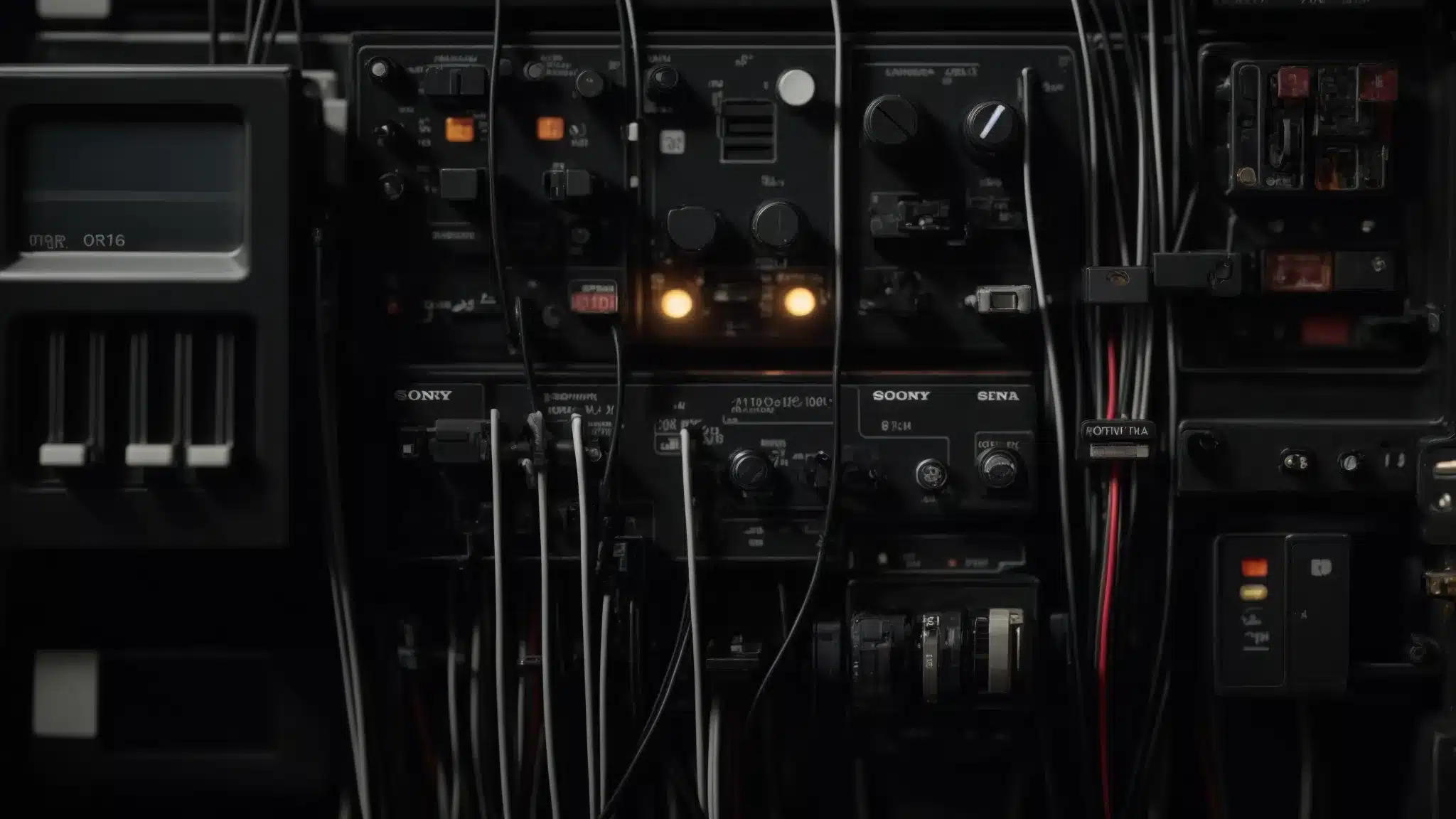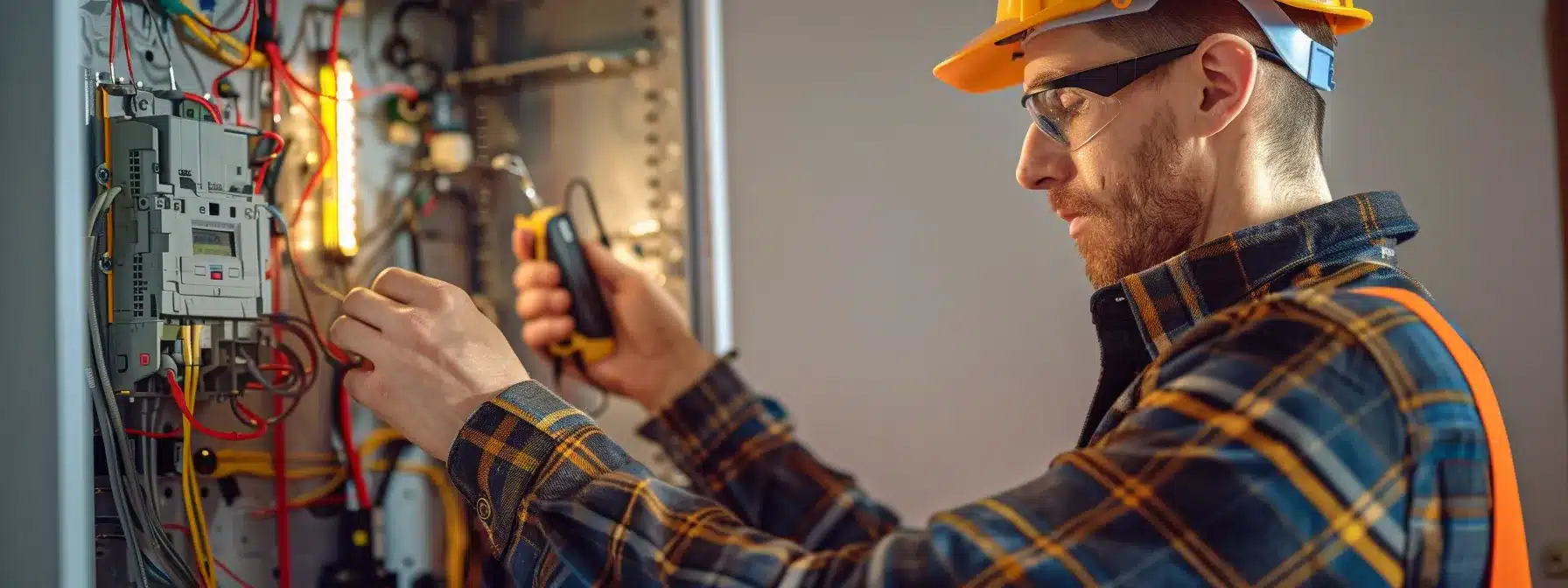Circuit breakers play a crucial role in protecting homes and businesses from electrical hazards, making their replacement a top priority when issues arise. When faced with a malfunctioning circuit breaker, seeking the expertise of an emergency electrician is essential to ensure proper installation and wiring. Prompt action not only safeguards your property but also maintains the integrity of your electrical services. In this article, we’ll explore the critical steps involved in urgent circuit breaker replacement, emphasizing safety throughout the process. Keep reading to discover why professional assistance is vital and how to maintain your new circuit breaker for optimal performance.
Key Takeaways
- Regular circuit breaker maintenance is crucial for home safety and electrical system efficiency
- Professional electricians ensure proper installation, code compliance, and diagnosis of underlying issues
- Warning signs like unusual noises or frequent tripping warrant immediate professional attention
- Updating electrical panels may be necessary to meet increased power demands and safety standards
- Proper cleaning and inspection can extend the life of circuit breakers and prevent failures
Recognizing the Need for Urgent Circuit Breaker Replacement

Circuit breakers play a crucial role in safeguarding homes and businesses from electrical hazards. When these vital components of the distribution board start showing signs of wear or malfunction, it’s essential to act swiftly. Recognizing the need for urgent replacement can prevent serious risks associated with faulty circuitry and unstable voltage. From frequent trips to unusual noises, several indicators suggest it’s time to call a qualified emergency electrician. While the price of replacement might seem daunting, it pales in comparison to the potential dangers of neglecting these warning signs.
Frequent Trips or Failures
Circuit breakers that trip frequently or fail to reset indicate a serious problem with the home’s electrical system. These issues often stem from a short circuit or ground fault, which can pose significant safety risks. Homeowners experiencing repeated breaker trips should contact an emergency electrical service promptly to assess the situation.
Persistent tripping might also signal an overloaded circuit, where the demand for electric power exceeds the breaker’s capacity. This overload can lead to overheating and potential fire hazards if left unaddressed. A qualified electrician can determine whether the issue requires a simple redistribution of loads or a more extensive circuit upgrade.
In some cases, frequent failures may be due to a faulty breaker itself, particularly in older homes with outdated electrical panels. Replacing aging circuit breakers is crucial for maintaining a safe and reliable power supply. Homeowners should never ignore these warning signs, as they could be the last line of defense against electrical fires and other dangerous situations.
Burning Smell or Visible Damage
A burning smell or visible damage to a circuit breaker demands immediate attention. This odor often indicates overheating, which can result from loose connections, worn insulation, or a failing breaker. Just as a malfunctioning furnace might emit strange smells, a circuit breaker giving off a burning odor is a clear sign of trouble.
Visible damage, such as scorch marks, melted plastic, or discoloration, signals a potentially hazardous situation. These signs suggest that the breaker has already experienced a significant malfunction or overheating event. Much like a blown fuse or a refrigerant leak, visible damage to a circuit breaker requires prompt professional intervention.
Homeowners should never ignore these warning signs or attempt DIY repairs. Instead, they should immediately shut off the main power supply and contact a licensed electrician for an urgent inspection. Swift action can prevent electrical fires and ensure the safety of the home’s occupants.
Circuit Breaker Won’t Stay Reset
A circuit breaker that won’t stay reset is a clear sign of an underlying electrical issue. This problem often indicates a persistent short circuit or ground fault in the system. Homeowners might notice this issue when attempting to restore power after a trip, only to find the breaker immediately flips back to the off position.
The inability to reset could stem from an overloaded circuit, especially in homes with high electrical loads from devices like air conditioning units. As temperatures rise and AC usage increases, the strain on the electrical system can cause breakers to trip repeatedly. This situation calls for immediate attention from a qualified electrician to assess and potentially upgrade the circuit capacity.
In some cases, a breaker that won’t stay reset may be due to a faulty breaker itself. Over time, the internal mechanisms can wear out, leading to unreliable performance. Replacing the faulty breaker is crucial for maintaining a safe and stable electrical system. Here’s a quick guide to common reasons for breaker reset issues:
Overheating Electrical Outlets
Overheating electrical outlets serve as a red flag for potential circuit breaker issues. These hot spots often indicate excessive current flow or loose connections within the outlet or wiring. Homeowners should be wary of warm or hot outlets, as they can lead to more serious electrical problems if left unchecked.
The heat generated by faulty outlets can damage surrounding materials, increasing the risk of electrical fires. This problem may stem from outdated wiring, improper installation, or a failing circuit breaker that’s not regulating the current effectively. Prompt action is crucial to prevent further damage and ensure the safety of the home’s electrical system.
When encountering overheating outlets, residents should immediately stop using them and contact a licensed electrician for a thorough inspection. The professional can determine whether the issue lies with the outlet itself or if it’s symptomatic of a larger problem with the circuit breaker or wiring. Here’s a quick guide to common outlet issues and their potential causes:
Physical Signs of Wear or Age
Circuit breakers, like any mechanical component, experience wear and tear over time. Physical signs of aging include discoloration, rust, or corrosion on the breaker’s surface. These visible indicators suggest the internal components may have deteriorated, potentially compromising the breaker’s ability to function properly.
Loose connections or wobbling breakers in the panel can also signal the need for immediate replacement. A breaker that feels unstable when touched or moves easily within its slot may not make proper contact with the bus bar, increasing the risk of electrical faults. Homeowners should never attempt to tighten or adjust breakers themselves, as this requires professional expertise.
Outdated breaker designs, especially in older homes, may lack modern safety features. For instance, homes built before the 1970s might have breakers without ground fault circuit interrupter (GFCI) or arc fault circuit interrupter (AFCI) protection. Upgrading to newer models can significantly enhance electrical safety and bring the home’s electrical system up to current code standards.
Buzzing or Humming Noises From the Panel
Buzzing or humming noises emanating from an electrical panel often indicate a serious problem with the circuit breakers or wiring. These sounds suggest loose connections, faulty breakers, or overloaded circuits, all of which can lead to electrical fires if left unchecked. Homeowners should never ignore these warning signs, as they could be the last line of defense against potential disasters.
The intensity and frequency of the noise can provide clues about the severity of the issue. A constant, low hum might indicate a minor problem, while intermittent buzzing or crackling sounds could signal a more urgent situation. In either case, it’s crucial to have a licensed electrician inspect the panel promptly to identify and address the root cause.
While it might be tempting to investigate the source of the noise, homeowners should resist the urge to open the electrical panel themselves. The interior of a panel contains live electrical components that pose significant risks to untrained individuals. Instead, they should cut power to non-essential circuits and contact a professional electrical service for an emergency inspection and potential circuit breaker replacement.
Don’t wait for disaster to strike! Discover the immediate advantages of upgrading your circuit breaker and safeguard your home today.
Immediate Benefits of Replacing Your Circuit Breaker

Swapping out an old or faulty circuit breaker for a new one brings a host of immediate advantages to homeowners and businesses alike. This crucial upgrade not only bolsters the safety of the electrical system but also prevents potential damage to appliances and electronics. Modern breakers often come with energy-saving features, helping to trim power bills while ensuring the property meets current electrical codes and standards. By investing in timely replacements, property owners can enjoy peace of mind knowing their electrical system is operating at peak efficiency and safety levels.
Enhanced Safety and Fire Prevention
Replacing outdated or faulty circuit breakers significantly enhances the safety of a home’s electrical system. New breakers react more quickly to overloads and short circuits, reducing the risk of electrical fires. This improved responsiveness protects both the property and its occupants from potential hazards.
Modern circuit breakers often include advanced safety features like arc fault detection. These mechanisms can identify and interrupt dangerous arcing faults before they lead to fires. Upgrading to these newer models provides an extra layer of protection against electrical accidents.
The installation of new circuit breakers also addresses potential weak points in the electrical system. Electricians typically inspect the entire panel during replacement, identifying and fixing any loose connections or worn wiring. This comprehensive approach ensures the entire electrical distribution system operates safely and efficiently.
Prevention of Electrical Damage
Replacing old circuit breakers prevents electrical damage to appliances and electronics. New breakers respond faster to power surges and overloads, protecting sensitive equipment from harmful voltage fluctuations. This quick response time can save homeowners thousands of dollars in potential repair or replacement costs for expensive devices.
Updated circuit breakers also help maintain consistent power quality throughout the home. They regulate voltage more effectively, reducing the risk of brownouts or power dips that can harm motors and electronic components. This stability extends the lifespan of household appliances and prevents premature wear and tear.
Modern circuit breakers often include built-in diagnostics that can alert homeowners to potential issues before they cause damage. These features allow for proactive maintenance, helping to catch and address electrical problems early on. Here’s a comparison of old vs. new circuit breakers in terms of electrical damage prevention:
Improved Energy Efficiency
Replacing old circuit breakers with modern, energy-efficient models can lead to significant improvements in a home’s overall energy consumption. New breakers often feature advanced load sensing capabilities, allowing them to distribute power more efficiently throughout the electrical system. This optimized power distribution can result in lower energy bills and reduced strain on the electrical grid.
Modern circuit breakers also contribute to energy efficiency by minimizing power leakage. They provide better insulation and tighter connections, reducing the amount of electricity lost through heat dissipation. This improved efficiency not only saves energy but also helps prevent overheating in the electrical panel, further enhancing safety.
Some new circuit breakers come equipped with smart technology, allowing homeowners to monitor and manage their energy usage more effectively. These smart breakers can provide real-time data on power consumption, helping users identify energy-hungry appliances and adjust their usage habits accordingly. By offering insights into energy patterns, these advanced breakers empower homeowners to make informed decisions about their electricity use, potentially leading to substantial energy savings over time.
Compliance With Electrical Codes and Standards
Replacing outdated circuit breakers ensures compliance with current electrical codes and standards. Many older homes have electrical systems that fall short of modern safety requirements, potentially putting residents at risk. Upgrading to new breakers helps bring the property up to code, ensuring it meets the latest safety guidelines set by local and national authorities.
Compliance with electrical codes often becomes crucial during property sales or renovations. Inspectors may flag non-compliant electrical systems, potentially delaying transactions or requiring costly last-minute upgrades. By proactively replacing old circuit breakers, homeowners can avoid these issues and ensure their property maintains its value.
Modern circuit breakers often include features required by updated electrical codes, such as GFCI and AFCI protection. These safety mechanisms provide enhanced protection against electrical shocks and fires, respectively. Upgrading to breakers with these features not only improves safety but also demonstrates a commitment to maintaining a code-compliant property:
- GFCI protection prevents electrical shocks in wet areas
- AFCI technology detects and interrupts dangerous arcing faults
- Dual function GFCI/AFCI breakers offer comprehensive protection
- Smart breakers provide remote monitoring and control capabilities
Ready to take the next step? Let’s explore how to choose the perfect circuit breaker for your home’s unique needs.
Choosing the Right Replacement for Your Circuit Breaker

Selecting the appropriate circuit breaker replacement is crucial for maintaining a safe and efficient electrical system. Homeowners must consider several factors to ensure they choose a breaker that meets their specific needs and complies with local electrical codes. From determining the correct size and type to understanding amp ratings, compatibility with existing systems, and exploring enhanced safety features, the process requires careful consideration. By focusing on these key aspects, property owners can make an informed decision that not only protects their home but also improves the overall performance of their electrical infrastructure.
Determine the Correct Size and Type
Determining the correct size and type of circuit breaker is crucial for maintaining a safe and efficient electrical system. Homeowners should first identify the amperage rating of the existing breaker, which typically ranges from 15 to 200 amps for residential applications. This information helps ensure the replacement breaker can handle the circuit’s load without tripping unnecessarily or allowing dangerous overloads.
The type of breaker needed depends on the specific requirements of the electrical panel and local building codes. Single-pole breakers protect 120-volt circuits, while double-pole breakers safeguard 240-volt appliances. Specialty breakers like GFCI or AFCI may be required for certain areas of the home, such as kitchens, bathrooms, or outdoor spaces.
When selecting a replacement, it’s essential to consider the breaker’s compatibility with the existing electrical panel. Different manufacturers use various designs, so homeowners should match the new breaker to their panel’s make and model. This ensures proper fit and function, preventing potential safety hazards and maintaining the integrity of the electrical system.
Understanding Amp Ratings
Amp ratings play a crucial role in selecting the right circuit breaker replacement. These ratings indicate the maximum amount of current a breaker can handle before tripping, protecting the circuit from overloads. Homeowners must match the new breaker’s amp rating to the existing wiring capacity to ensure safe operation.
Common residential circuit breaker amp ratings include 15, 20, 30, 40, and 50 amps. Smaller appliances and lighting circuits typically use 15 or 20-amp breakers, while larger appliances like electric dryers or ovens may require 30 to 50-amp breakers. Choosing a breaker with too high an amp rating can lead to overheating and potential fire hazards.
When replacing a circuit breaker, it’s essential to consult the electrical panel’s label or a licensed electrician to verify the correct amp rating. Upgrading to a higher amp rating often requires rewiring the entire circuit, which should only be done by a qualified professional. This ensures the electrical system remains safe and compliant with local building codes.
Compatibility With Your Electrical System
Ensuring compatibility between new circuit breakers and the existing electrical system is paramount for safety and performance. Homeowners must verify that the replacement breaker matches the panel’s brand and type to guarantee proper fit and function. Using incompatible breakers can lead to loose connections, overheating, and potential electrical failures.
The age and condition of the electrical panel also play a role in compatibility. Older panels may require specialized breakers that are no longer widely available, necessitating a panel upgrade. Homeowners should consult with a licensed electrician to assess whether their current panel can accommodate modern breakers or if a more comprehensive update is needed.
Compatibility extends beyond physical fit to include technological aspects. Smart home systems and energy monitoring devices may require specific types of circuit breakers to function correctly. Homeowners investing in these advanced features should ensure their chosen breakers support the desired functionality, allowing for seamless integration with their home automation setup.
Features for Enhanced Safety
Modern circuit breakers offer advanced safety features that go beyond basic overload protection. Arc fault circuit interrupters (AFCIs) detect dangerous electrical arcs, while ground fault circuit interrupters (GFCIs) protect against electrocution in wet areas. These enhanced safety mechanisms significantly reduce the risk of electrical fires and shocks in homes.
Some newer breakers incorporate dual-function technology, combining AFCI and GFCI protection in a single unit. This integration provides comprehensive safety coverage for various electrical hazards, making it an excellent choice for areas that require both arc fault and ground fault protection. Homeowners can benefit from this all-in-one solution, simplifying installation and maintenance while maximizing safety.
Smart circuit breakers represent the latest advancement in electrical safety technology. These devices allow remote monitoring and control of electrical circuits through smartphone apps or home automation systems. Smart breakers can alert homeowners to potential issues, track energy usage, and even shut off power to specific circuits remotely, adding an extra layer of convenience and security to the home’s electrical system.
Time’s ticking, and your electrical safety hangs in the balance. Let’s dive into the urgent process of replacing your circuit breaker, ensuring your home stays protected.
Step-by-Step Guide to Urgent Circuit Breaker Replacement

When faced with a faulty circuit breaker, swift action is crucial to ensure the safety and functionality of a home’s electrical system. This step-by-step guide outlines the process of urgently replacing a circuit breaker, from cutting off the main power supply to testing the newly installed component. While it’s always recommended to seek professional help for electrical work, understanding these steps can help homeowners grasp the complexity of the task and communicate effectively with their electrician. Safety remains paramount throughout the procedure, emphasizing the importance of proper precautions and expertise in handling electrical components.
Switch Off the Main Power Supply
Before attempting any circuit breaker replacement, safety must be the top priority. Homeowners should locate the main power supply switch, typically found in the electrical panel or near the utility meter. This switch controls power to the entire house and must be turned off to prevent electrical shock during the replacement process.
After identifying the main power switch, homeowners should inform all occupants about the impending power outage. This step ensures everyone’s safety and prevents disruptions to ongoing activities. It’s advisable to have flashlights or battery-powered lanterns on hand for visibility during the procedure.
Once the main power is off, homeowners should verify the absence of electricity using a non-contact voltage tester. This crucial step confirms that no live current flows through the circuits, creating a safe environment for the replacement process. Here’s a quick checklist for switching off the main power supply:
- Locate the main power switch in the electrical panel or near the meter
- Inform all household members about the planned power outage
- Turn off the main power switch firmly and decisively
- Use a non-contact voltage tester to confirm power disconnection
- Prepare alternative light sources for the duration of the replacement
Remove the Old Circuit Breaker
Removing the old circuit breaker requires careful attention to detail and a steady hand. After ensuring the main power is off, the electrician will open the panel cover to access the breakers. They’ll identify the faulty breaker, noting its position and connections for reference during installation of the replacement.
The electrician will then gently loosen the wire connections attached to the old breaker. This step demands precision to avoid damaging surrounding components or disturbing other wires. Once the connections are free, the technician can carefully pull the old breaker from its slot in the panel.
Before discarding the old breaker, the electrician will inspect it for signs of damage or wear. This examination can provide valuable insights into potential issues within the electrical system, helping to prevent future problems. The removed breaker should be disposed of properly, following local regulations for electronic waste.
Install the New Circuit Breaker
Installing the new circuit breaker requires precision and care. The electrician aligns the replacement breaker with the panel’s bus bar, ensuring a secure fit. They then firmly push the breaker into place, listening for a clicking sound that indicates proper connection.
Once seated, the technician reattaches the wires to the new breaker, following the same configuration as the old unit. They tighten the connections to the manufacturer’s specifications, preventing loose wires that could cause overheating or electrical failures. The electrician double-checks all connections to ensure they’re snug and properly positioned.
Before closing the panel, the technician inspects the surrounding area for any debris or loose components that could interfere with the breaker’s operation. They ensure the breaker sits flush with other units in the panel, indicating correct installation. This final visual check helps prevent potential issues and ensures the new breaker integrates seamlessly with the existing electrical system.
Restore Power and Test the New Breaker
After installing the new circuit breaker, the electrician carefully restores power to the home. They close the main panel cover and switch on the main power supply. This step-by-step process ensures a safe return to full electrical functionality.
The technician then tests the new breaker by turning it on and off several times. They listen for any unusual sounds and check for smooth operation. This initial test helps confirm proper installation and functionality.
To complete the process, the electrician verifies power restoration to the affected circuit. They use electrical devices or appliances connected to that circuit to ensure everything works correctly. This final check guarantees the new breaker performs its job effectively, protecting the home’s electrical system.
Circuit breaker replacement demands precision and expertise. Let’s explore why calling in the pros can save you time, money, and potential hazards.
Why Professional Assistance Is Critical for Circuit Breaker Replacement

While some homeowners might be tempted to tackle circuit breaker replacement as a DIY project, professional assistance is crucial for ensuring the safety and longevity of a home’s electrical system. Licensed electricians bring a wealth of knowledge and experience to the task, providing far more than just a simple swap-out service. From guaranteeing proper installation and identifying potential underlying issues to ensuring compliance with local electrical codes, professionals offer a comprehensive approach to circuit breaker replacement. Their expertise, combined with access to specialized tools and up-to-date industry knowledge, makes them indispensable for maintaining a safe and efficient electrical infrastructure in any home or business.
Ensuring Proper Installation and Safety
Professional electricians ensure proper installation and safety when replacing circuit breakers. They possess the expertise to handle complex electrical systems and understand the nuances of different breaker types. Their training allows them to identify potential hazards that might escape the notice of untrained individuals.
Licensed professionals follow strict safety protocols during the replacement process. They use specialized tools and equipment to minimize risks and ensure the new breaker functions correctly within the existing electrical panel. Their experience helps prevent common mistakes that could lead to electrical fires or system failures.
Electricians also provide valuable guidance on selecting the right breaker for specific needs. They consider factors like amperage requirements, compatibility with the panel, and local electrical codes. This expertise helps homeowners avoid the dangers of using incorrect or incompatible breakers, which could compromise the entire electrical system’s safety.
Diagnosing Underlying Electrical Issues
Professional electricians excel at diagnosing underlying electrical issues during circuit breaker replacements. They use their extensive knowledge and specialized tools to identify problems that may not be immediately apparent. This thorough approach helps prevent future electrical failures and ensures the longevity of the home’s electrical system.
Electricians can spot signs of overloaded circuits, faulty wiring, or degraded insulation that might contribute to breaker failures. They assess the overall condition of the electrical panel, checking for corrosion, loose connections, or outdated components that could pose safety risks. This comprehensive evaluation often reveals issues that extend beyond the faulty breaker itself.
By addressing these underlying problems, professionals help homeowners avoid costly repairs and potential safety hazards down the line. They can recommend necessary upgrades or repairs to improve the overall performance and safety of the electrical system. This proactive approach saves time and money in the long run, ensuring a reliable and efficient electrical setup for years to come.
Guaranteeing Compliance With Local Codes
Professional electricians ensure compliance with local electrical codes when replacing circuit breakers. They stay up-to-date with the latest regulations and standards, which often vary by region. This knowledge helps homeowners avoid potential legal issues and safety hazards associated with non-compliant installations.
Licensed professionals understand the specific requirements for different types of buildings and electrical systems. They can determine if additional upgrades are necessary to bring the entire electrical panel up to code. This expertise is particularly valuable for older homes that may have outdated wiring or panels.
Electricians also provide proper documentation for the work performed, which can be crucial for insurance purposes or future home sales. They can obtain necessary permits and arrange for inspections, ensuring the replacement meets all local requirements. Here’s a comparison of DIY versus professional circuit breaker replacement in terms of code compliance:
Access to the Right Tools and Expertise
Professional electricians bring specialized tools and equipment to circuit breaker replacements that aren’t typically available to homeowners. These tools ensure precise measurements, safe handling of live components, and efficient installation of new breakers. Their expertise in using these tools minimizes the risk of damage to the electrical panel or surrounding components.
Electricians possess in-depth knowledge of various breaker types and panel configurations. This expertise allows them to quickly identify compatible replacements and navigate complex electrical systems with ease. They can efficiently troubleshoot issues that may arise during the replacement process, saving time and preventing potential complications.
The ongoing training and certification requirements for licensed electricians keep them updated on the latest industry standards and technological advancements. This current knowledge ensures that homeowners receive the most up-to-date solutions for their electrical needs. Professional electricians can offer valuable advice on energy-efficient options and smart home integrations that may benefit the household in the long run.
Your new circuit breaker promises safety and reliability, but the job isn’t over yet. Let’s explore how to keep your electrical system in top shape for years to come.
Maintaining Your New Circuit Breaker for Longevity

After replacing a circuit breaker, proper maintenance is crucial to ensure its longevity and continued effectiveness. Regular upkeep not only extends the life of the new breaker but also helps maintain the safety and efficiency of the entire electrical system. Homeowners should establish a routine that includes periodic inspections, cleaning, and monitoring for potential issues. By staying proactive with maintenance, they can prevent unexpected failures, reduce the risk of electrical fires, and avoid costly replacements down the line. Understanding when to update the electrical panel and recognizing early warning signs of trouble are also essential aspects of responsible circuit breaker care.
Regular Inspection and Testing
Regular inspection and testing of new circuit breakers are crucial for maintaining their performance and safety. Homeowners should schedule annual checkups with a licensed electrician to ensure everything is functioning correctly. These professionals can identify potential issues before they become serious problems, saving time and money in the long run.
During inspections, electricians check for signs of wear, loose connections, and proper operation of the breaker mechanisms. They may perform load tests to verify that the breaker trips at the correct amperage, ensuring it provides adequate protection for the circuit. This thorough examination helps prevent unexpected failures and electrical hazards.
Homeowners can also conduct simple visual inspections between professional checkups. They should look for any signs of discoloration, burning smells, or unusual noises coming from the electrical panel. If any of these issues are detected, it’s important to contact a professional immediately. Regular maintenance and vigilance can significantly extend the life of a circuit breaker and maintain the safety of the home’s electrical system:
- Schedule annual professional inspections
- Perform monthly visual checks for signs of damage
- Listen for unusual sounds from the electrical panel
- Test GFCI and AFCI breakers monthly using their test buttons
- Keep a log of any issues or tripping incidents
Keeping the Circuit Breaker Panel Clean
Keeping the circuit breaker panel clean is essential for maintaining its efficiency and safety. Dust, debris, and moisture can accumulate over time, potentially causing corrosion or interfering with the breakers’ operation. Regular cleaning helps prevent these issues and allows for easier visual inspections.
Homeowners should gently vacuum the exterior of the panel and around the breakers using a soft brush attachment. This removes loose dust and cobwebs without disturbing the internal components. For stubborn dirt, a slightly damp cloth can be used to wipe down the panel’s exterior, taking care not to let any moisture enter the box.
It’s crucial to avoid using cleaning sprays or liquids inside the panel, as these can damage the electrical components or create hazardous conditions. If the interior of the panel requires cleaning, it’s best to consult a licensed electrician who can safely power down the system and perform a thorough cleaning without risking damage or electrical shock.
Updating Your Electrical Panel When Necessary
Updating the electrical panel becomes necessary when the home’s power demands outgrow the current system’s capacity. Homeowners should consider an upgrade if they frequently experience tripped breakers, dimming lights, or if they plan to add major appliances or renovate. An outdated panel poses safety risks and may not meet current electrical codes.
A licensed electrician can assess whether the panel needs updating by evaluating its age, condition, and capacity. They’ll consider factors like the home’s square footage, the number of circuits, and the types of appliances in use. If an upgrade is recommended, the electrician will suggest an appropriate amperage for the new panel based on the household’s electrical needs.
The process of updating an electrical panel involves replacing the old unit with a newer, higher-capacity model. This upgrade often includes installing new circuit breakers, rewiring certain areas of the home, and ensuring compliance with local building codes. While costly, updating the electrical panel enhances safety, improves energy efficiency, and prepares the home for future technological advancements.
Monitoring for Any Signs of Trouble
Homeowners should remain vigilant for signs of trouble with their new circuit breaker. Unusual noises, such as buzzing or clicking sounds coming from the electrical panel, warrant immediate attention. Strange odors, particularly a burning smell, indicate a potentially serious issue that requires professional inspection.
Frequent tripping of the new breaker suggests an underlying problem that needs addressing. Homeowners should note patterns in when and how often the breaker trips, as this information can help electricians diagnose the issue. Visible damage, such as scorch marks or melted plastic on the breaker, demands urgent professional intervention.
Changes in the performance of electrical devices throughout the home can signal breaker problems. Flickering lights, appliances that suddenly lose power, or outlets that feel warm to the touch all merit investigation. By promptly addressing these warning signs, homeowners can prevent more serious electrical issues and maintain the safety of their home’s electrical system.

